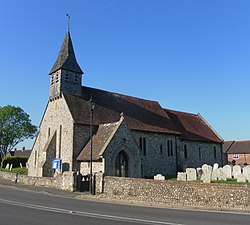Mid Lavant
| Mid Lavant | |
| Sussex | |
|---|---|
 Church of St Nicholas, Mid Lavant | |
| Location | |
| Grid reference: | SU856085 |
| Location: | 50°52’12"N, -0°47’3"W |
| Data | |
| Population: | 1,656 (2011) |
| Post town: | Chichester |
| Postcode: | PO18 |
| Local Government | |
| Council: | Chichester |
| Parliamentary constituency: |
Chichester |
Mid Lavant is a village in Sussex, two miles north of the county town, Chichester, in the very west of the county. To the east stands East Lavant[1] and to the west the much smaller West Lavant. The three villages take their shared name from the River Lavant which flows from East Dean to Chichester.
The A286 road between Chichester and Midhurst runs through the parish.
The villages were served by a station in Mid Lavant, on the railway line that ran between Chichester and Midhurst, but this closed in stages between 1931 and 1991.
History
Prehistory
In 1993, the Lavant drum, a small Neolithic cylinder, was discovered during excavations at Chalk Pit Lane. It is one of only five known objects of its type, and the only one discovered outside of Yorkshire. (The other four were all found in the East Riding of Yorkshire: the three Folkton drums discovered in 1889,[2] and the Burton Agnes drum, discovered in 2015 in Burton Agnes, to the south of Folkton.[3]) It has been suggested that these objects were tools used to measure cord to standard lengths which could be used in the construction of monuments.[4]
Mid Lavant is listed a Loventone in the Domesday Book of 1086 as having 20 households: 10 villagers and 10 smallholders; with ploughing land and a mill, it had a value to the lords of the manor, Guy of Lavant and Ivo of Grandmesnil, of £9.[5]
In 1861, the area of the small parish was 350 acres, and described in Kelly's Directory of 1867 as "principally arable". The population in 1861 was 257. The Duke of Richmond was the principal landowner and patron of the parish church.[6] The village pub is named after the Earl of March.
The parish church is dedicated to St Nicholas.
About the village
Kingley Vale lies on the border of the parish; it is a Site of Special Scientific Interest, a national nature reserve and is noted for its yew woodlands.[7] Archaeological remains from the Bronze Age, Iron Age and Roman times have been identified.[8][9]
Sport
- Cricket: Lavant Cricket Club.[10]
- Football: Lavant Football Club
References
- ↑ Information on Mid Lavant from GENUKI
- ↑ Kenny, James; Teather, Anne M. (2016). "New insights into the Neolithic chalk drums from Folkton (North Yorkshire) and Lavant (West Sussex)" (in en). PAST: The Newsletter of the Prehistoric Society 83: 5–6. https://www.academia.edu/29585550.
- ↑ 'British Museum’s Stonehenge exhibition adds 'most important prehistoric art find in 100 years'': Museums + Heritage Advisor, 10 February 2022
- ↑ Teather, Anne; Chamberlain, Andrew; Parker Pearson, Mike (2019-01-02). "The chalk drums from Folkton and Lavant: Measuring devices from the time of Stonehenge" (in en). British Journal for the History of Mathematics 34 (1): 1–11. doi:10.1080/17498430.2018.1555927. SSN 2637-5451.
- ↑ Lavant Mid Lavant in the Domesday Book
- ↑ "Laughton - Laverstoke Pages 33-37 A Topographical Dictionary of England. Originally published by S Lewis, London, 1848.". https://www.british-history.ac.uk/topographical-dict/england/pp33-37.
- ↑ SSSI listing and designation for Kingley Vale
- ↑ Down, Alec (1979). "Gazeteer of Sites and Finds". Chichester Excavations (Chichester: Phillimore & Co. Ltd.) 4: 36–7. ISBN 0-85033-344-X.
- ↑ Boyden, J. R. (1956). "Excavations at Goosehill Camp, 1953-5". Sussex Archaeological Collections 94: 70–99. doi:10.5284/1085886.
- ↑ Lavant Cricket Club